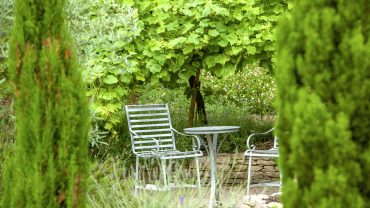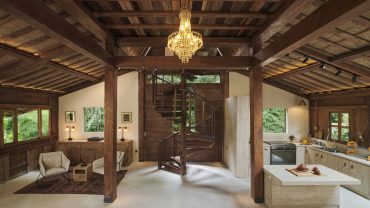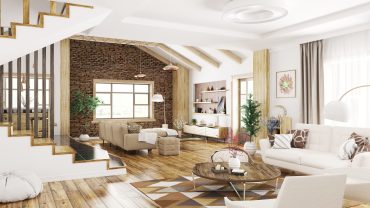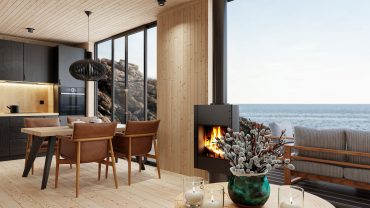Contemporary garden design thrives on contrast. It’s bold yet minimalist, organic yet structured. This delicate balance results in outdoor spaces that feel both sculptural and inviting – where modern aesthetics meet functional beauty.
But what makes a garden truly contemporary? From striking landscaping choices to unconventional plant combinations, we’re exploring the best contemporary garden ideas to create an outdoor space that’s as stylish as it is serene.
What is Contemporary Design?

Modern garden design (Credit: stocknshares via Getty Images)
Before diving into contemporary garden ideas, it’s worth understanding the core principles behind the style. Contemporary design embraces clean lines, simplicity, and a thoughtful mix of natural materials and modern innovation. When applied to outdoor spaces, it creates a seamless transition between indoors and out, turning the garden into an essential extension of the home. With this in mind, there are plenty of ways to craft a sophisticated modern garden design.
Lines Meet Loops

Clean lines in a modern garden (Credit: runna10 via Getty Images)
At its core, modern style landscape design leans towards clean, angular lines – think rectangular patios, sharp-edged pathways, and structured layouts. This minimalist approach creates a sense of order and elegance. Yet, too much rigidity can sometimes feel stark or uninviting. The trick? Soften the look with curves. A circular patio, rounded flower beds, or a meandering water feature can introduce a more organic feel, ensuring the space remains sleek but welcoming.
Picky Planting

How does your garden grow... (Credit: Wirestock via Getty Images)
In contemporary garden design, every plant has a purpose. The goal is cohesion – neat rows, geometric patterns, and carefully considered combinations. Achieving this structured look requires a “less is more” approach. Fewer plant varieties create a cleaner aesthetic, while mono-planting (grouping the same plants together) enhances visual impact. Sculptural plants like agave, yucca, and neatly trimmed topiary add definition, bringing bold shapes and striking silhouettes into the mix.
Complementary Contrasts

Contrasting materials work well in modern gardens (Credit: Tom Merton via Getty Images)
Striking a balance between contrasting materials is key to creating depth and interest. Modern gardens often pair smooth with textured, natural with industrial, or dark with light. A sleek concrete path alongside rustic wooden decking, for example, adds a dynamic edge, while metal planters set against soft greenery create an eye-catching contrast. The right mix of materials brings both harmony and drama to the design.
Low Maintenance, Low Impact

Recycled materials are very popular in contemporary gardens (Credit: Ekaterina Demidova via Getty Images)
Contemporary garden design isn’t just about aesthetics, it’s about functionality too. That’s why low-maintenance landscaping plays a major role. Drought-tolerant plants like succulents, ornamental grasses, and wildflowers keep the space lush with minimal effort, reducing the need for frequent watering. Sustainable materials, such as composite decking and fencing made from recycled content, can further enhance the garden’s eco-friendliness. These choices not only minimise upkeep but also contribute to a more sustainable approach to modern garden designs.
Going Vertical

Outdoor vertical gardens are popular in smaller spaces (Credit: Lisa Stokes via Getty Images)
For those working with limited outdoor space, vertical gardening can offer a stylish and practical solution. Green walls, trellises, and hanging planters can transform blank surfaces into lush, living art. Trailing ivy, ferns, and even edible herbs can be layered to create depth and texture. This approach is particularly effective in urban courtyards and compact patios, where every inch of space has potential.
Water as a Feature

A stunning water feature in a minimalist garden (Credit: AndrewFurlongPhotography via Getty Images)
Water has a way of adding tranquillity to an outdoor setting, and in modern gardens, simplicity is key. Instead of ornate fountains, contemporary garden design favours minimalist water features such as reflective pools, sleek stone channels, and shallow concrete basins with gentle ripples. Dark water surfaces amplify reflections, enhancing the look while maintaining a calming atmosphere.
Bringing the Inside Out

A covered patio brings the outside inside, or vice-versa... (Credit: hikesterson via Getty Images)
Modern garden designs often blur the line between indoors and out, turning outdoor spaces into functional extensions of the home. A covered patio with heating can feel like an extra living room, while built-in seating, outdoor kitchens, and shaded pergolas define spaces for dining, lounging, and entertaining. Modular furniture allows for flexibility, adapting the space to different seasons and occasions. With thoughtful planning, a garden can be as much a part of daily life as any room inside the house.
Dazzling Contemporary Garden Lighting Ideas

Stunning modern garden lighting (Credit: skynesher via Getty Images)
When exploring contemporary garden lighting ideas, the key to a stunning outdoor space after dark lies in thoughtful layering. Combining various lighting elements can enhance both functionality and aesthetics. Hidden LED strips offer a subtle glow, recessed pathway lights improve safety, and sculptural lanterns add character. Meanwhile, dramatic uplighting highlights trees and architectural features, while warm-toned fixtures around seating areas can create an inviting ambiance. By integrating these modern lighting techniques, you can transform your garden into a beautifully illuminated retreat.
Sustainable and Eco-Friendly Elements

Sustainable garden design (Credit: Dulyanut Swdp via Getty Images)
Sustainability is at the heart of modern style landscape design, with eco-conscious choices woven into both aesthetics and function. Some sustainable features include:
- Native plants that require less maintenance and support biodiversity.
- Permeable paving, such as gravel or reclaimed stone, to reduce water runoff.
- Rain gardens and bioswales that manage excess moisture naturally.
- Solar-powered lighting and water-efficient irrigation systems to reduce energy use.
By integrating these elements, contemporary gardens can become as environmentally responsible as they are visually compelling.
More Contemporary Garden Ideas

Raised planters work well in contemporary gardens (Credit: simonkr via Getty Images)
There are plenty more contemporary garden ideas where those came from, such as:
- Raised planters in metal or corten steel for a sleek, architectural look.
- Abstract sculptures or artistic screens to serve as focal points.
- Strategically placed mirrors to create the illusion of more space.
- Bold pops of colour, whether through statement furniture, ceramic pots, or vibrant garden walls.
A Contemporary Garden that feels Bold and Natural

Modern gardens strike the perfect balance (Credit: Paul Bradbury via Getty Images)
As we’ve seen, modern garden design is all about balance – between structure and nature, sharp edges and organic curves, sleek surfaces and lush greenery. The beauty of modern gardens lies in their ability to be both bold and calming, striking yet harmonious. By blending innovative design with natural elements, the result is an outdoor space that can feel effortlessly stylish and warmly inviting.












